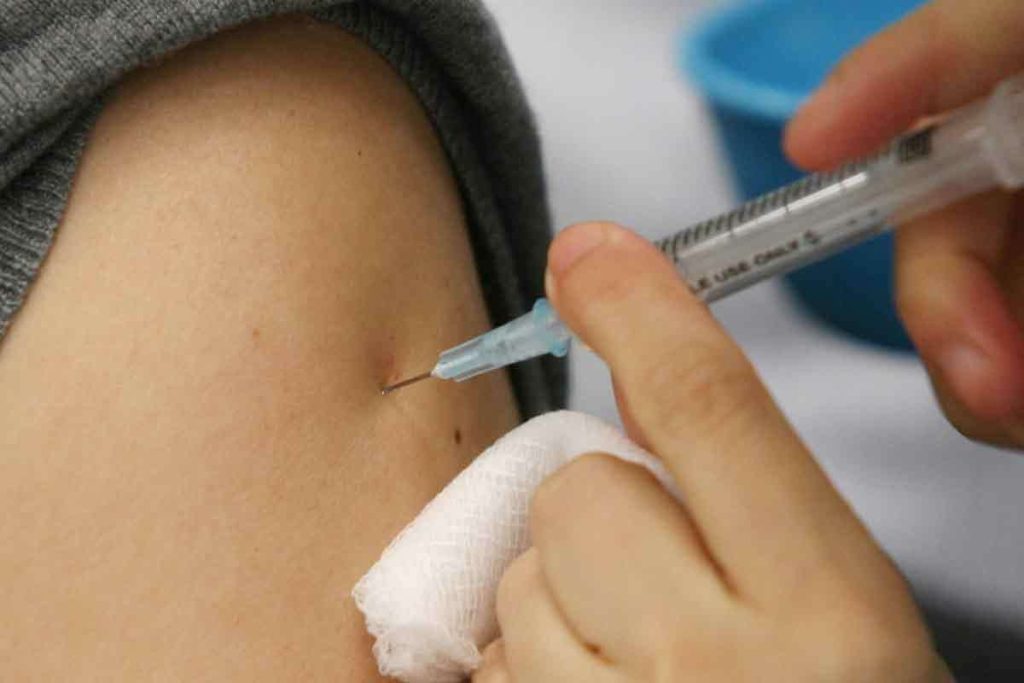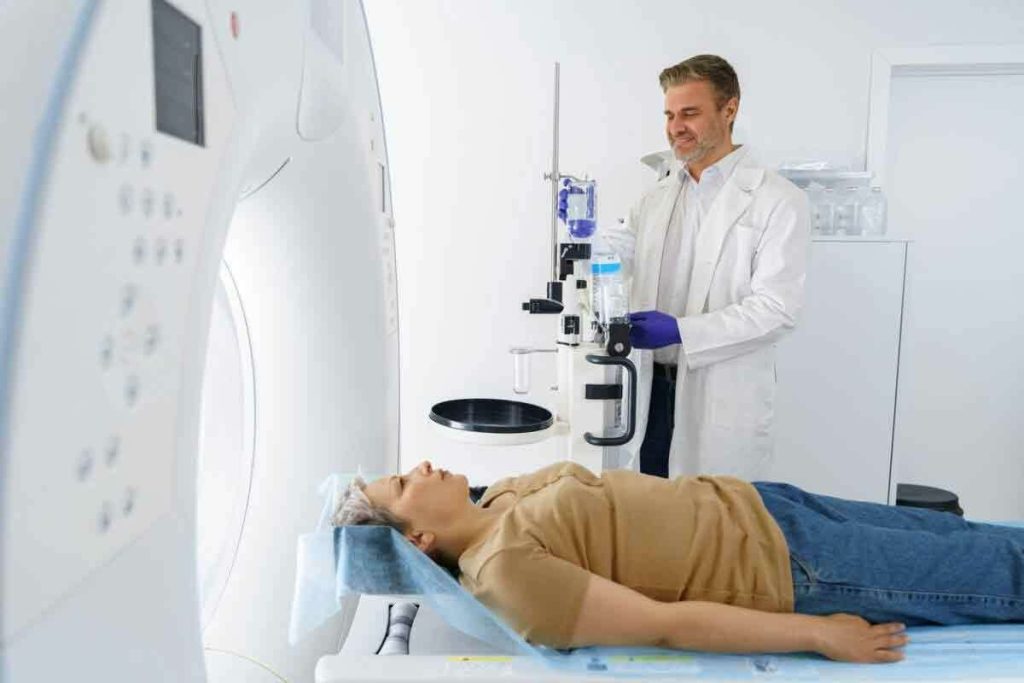
Are you getting ready for a CT scan and wondering about the injected dye used? At Liv Hospital, we make sure you get safe, clear, and top-notch imaging care. CT scans use CT contrast media to make diagnoses more accurate.
Names like iohexol and iopamidol are common contrast dye names. It’s key for patients to know about the different contrast dyes, their features, and possible dangers before a CT scan.

Contrast agents in CT scans have changed medical imaging a lot. They make images clearer and more detailed. This helps doctors make better diagnoses and treatment plans.
Contrast media, or agents, are used to make body structures or fluids stand out in medical images. In CT scans, they usually have iodine. Iodine absorbs X-rays, making blood vessels, organs, and other parts more visible. Radiology guidelines say using contrast media is common in many CT scans.
Contrast agents make images clearer, helping doctors see the body’s internal structures better. Here’s how they help:
By making CT images clearer, these agents help doctors make more accurate diagnoses. This is key for creating effective treatment plans.

The world of CT contrast agents is vast, with many options available. Each has its own characteristics and uses. Knowing the different contrast dye names is key for medical professionals and patients. This knowledge improves diagnostic accuracy and helps manage side effects.
Iohexol, known as Omnipaque, is a non-ionic iodinated contrast agent. It’s great for many CT procedures, like ct dye injection for vascular and organ imaging. Omnipaque has low osmolality, which lowers the risk of bad reactions. We often choose iohexol for contrast injection ct scans because of its safety.
Iohexol is used in many CT exams, including head, body, and vascular studies. It helps see blood vessels and organs clearly, making it very useful in radiology.
Iopamidol, known as Isovue, is another iodinated contrast medium. It has low viscosity and osmolality, making it good for many ct dye injection procedures. Isovue is used for CT scans of the head, neck, and body, providing great contrast for diagnosis.
Iopamidol is versatile and reliable in different clinical settings. We use Isovue for various CT exams, appreciating its clarity in diagnostic images.
There are many iodinated contrast agents used in CT procedures, aside from iohexol and iopamidol. These include ioversol (Optiray), iodixanol (Visipaque), and iobitridol (Xenetix). Each has its own properties and is chosen based on the CT scan’s needs and the patient’s factors.
Knowing the different contrast dye names and their characteristics is key to optimizing CT scan protocols. It helps minimize the risk of iodine contrast side effects. By choosing the right contrast agent for each patient, we can improve diagnostic accuracy and ensure patient safety.
Knowing what’s in contrast dye is key for patients getting CT scans. These agents are made to improve image quality and keep patients safe.
We’ll look at the main parts of CT contrast media. This includes the main ingredient and other additives that help them work well.
The main part of most CT contrast media is iodine. It helps make images clearer by blocking X-rays. Iodine-based agents are popular because they’re safe and effective.
CT contrast media also have additives and stabilizers to make them better. These include:
These extras help reduce bad reactions and improve the agent’s quality.
For some non-vascular studies, barium sulfate is used instead. It’s good for looking at the GI tract.
“Barium sulfate is insoluble in water and is not absorbed by the GI tract, making it safe for oral or rectal administration.” – Medical Imaging Guide
Barium sulfate coats the GI tract, making it easy to see on CT images. It’s a safe and effective choice for certain tests.
CT contrast media work by blocking X-rays, making images clearer. It contains iodine or barium that spreads through blood vessels and organs. This changes how these areas absorb X-rays.
Iodine, the main part of CT contrast media, absorbs X-rays well. This makes areas with iodine look denser on CT scans. It helps them stand out more against other tissues.
After being given through a vein, contrast media goes through the body’s blood. It first goes to the heart, then the lungs, and then all over the body. How fast and how much it spreads depends on the contrast agent, the patient’s heart health, and any blood vessel problems.
The kidneys are key in getting rid of contrast media. Iodinated contrast agents are mostly filtered out by the kidneys. How well this happens can be affected by kidney health. Poor kidney function can slow down this process and increase the risk of kidney problems.
| Process | Description | Key Factors |
| X-ray Attenuation | Iodine absorbs X-rays, making structures appear denser | Iodine concentration, X-ray energy |
| Distribution | Contrast media spreads through blood vessels and organs | Cardiovascular status, contrast agent properties |
| Elimination | Kidneys filter out contrast media | Renal function, hydration status |
Knowing how CT contrast media work is key to using them safely and effectively. It helps doctors understand CT scans better. This leads to better diagnosis and treatment.
There are different ways to give contrast media for CT scans. This depends on the type of scan and what area is being looked at. Knowing these methods helps patients get ready for their scans and doctors get the best images.
Intravenous (IV) contrast is the most common way for CT scans. It means putting contrast media into a vein, usually in the arm. This helps see blood vessels and organs as the contrast moves through the blood.
IV contrast is great for looking at the liver, pancreas, and blood vessels. It also helps find tumors and check for vascular diseases.
Using IV contrast makes CT scans more accurate, which is important for detailed blood vessel images. Most people find the injection okay, but some might feel a warm feeling or taste something metallic.
Oral contrast media helps see the GI tract in CT scans. Patients drink a contrast agent, like barium or iodine, before the scan. How much and when to drink it depends on the scan type and what’s being looked at.
We tell patients how to prepare and when to drink the oral contrast. This makes sure the GI tract is well seen, helping doctors see what they need to.
Rectal contrast involves putting contrast media into the rectum with an enema tip. It’s used to see the rectum and sigmoid colon in CT scans. It’s good for finding rectal tumors, fistulas, and abscesses.
We use rectal contrast for detailed images of the rectum and lower colon. The process is done in a safe place, and patients are watched for any issues.
When you’re getting ready for a CT scan with contrast dye, knowing what to expect can help you feel less anxious. We help patients through every step, from getting ready to checking in after the scan. This way, you can have a smooth experience.
Before your CT scan with contrast dye, there are some things you need to do. These include:
When you get the CT contrast injection, you might feel some things. These can be:
These feelings usually don’t last long and go away after the scan is done.
After your CT scan with contrast dye, we watch for any bad reactions. Our medical team will:
By knowing what to expect from the CT dye injection, you can prepare better. And you’ll know what to expect during and after the scan.
It’s important to know about the side effects of contrast media in CT scans. This knowledge helps keep patients safe and informed. When contrast dye is used in a CT scan, patients might feel different reactions. These can range from mild discomfort to serious problems.
Most mild reactions to CT contrast media happen right after the scan. They usually go away quickly. Some common mild reactions include:
These reactions are usually not serious. But it’s key to tell your doctor if you feel any discomfort during or after the scan.
Some people might experience delayed reactions to the contrast media. These can happen hours to days after the scan. Some common delayed reactions include:
Most delayed reactions are mild. But it’s important to watch your body and see a doctor if symptoms don’t go away or get worse.
Even though rare, severe reactions to CT contrast media can happen. These need quick medical help. Severe reactions might include:
It’s vital to act fast if you see severe reactions. Tell your doctor about any allergies or past reactions to contrast media before your CT scan.
In summary, knowing about the side effects of contrast media in CT scans is key. Being aware and taking steps to stay safe can help. If you have concerns or notice any side effects, talk to your doctor.
It’s important to know the long-term effects of CT scan dye. This is true for both doctors and patients. As CT scans with dye become more common, we need to look at how they might affect health over time.
One big worry with CT scan dye is contrast-induced nephropathy (CIN). This is when kidney function suddenly gets worse after dye is used. Risk factors include kidney disease, diabetes, dehydration, and high doses of dye.
To avoid CIN, doctors check if a patient is at risk before using dye. They use several ways to prevent it:
| Risk Factor | Prevention Strategy |
| Pre-existing kidney disease | Check kidney function before, consider other imaging options |
| Diabetes | Keep an eye on blood sugar, and make sure to drink enough water |
| Dehydration | Follow hydration plans before and after the scan |
Iodine in dye can mess with the thyroid, mainly in those with thyroid issues. It can cause both too much and too little thyroid hormone.
People with thyroid problems need to be watched after getting dye. Sometimes, doctors might take steps to prevent thyroid problems.
Having many CT scans with dye can have long-term effects. Even though the body gets rid of dye, too much can build up in some tissues.
Studies are looking into how often dye is used and its long-term effects. Doctors have to think about the benefits of dye-enhanced scans and the risks when planning tests.
New studies are looking into the safety of CT scan dye over time. They’re checking for long-term harm, like to the kidneys and thyroid.
A recent look at studies shows we know about short-term risks. But we’re just starting to learn about long-term effects. More research is needed to guide the safe use of dye in different patients.
Using contrast media in CT scans requires careful thought for certain patients. Some patients are more likely to have bad reactions to contrast agents. It’s important for doctors to know these risks to keep patients safe during tests.
People with kidney disease face a risk of kidney damage from contrast media. We check their kidney health before the scan. This helps us decide if they’re at high risk.
For those at high risk, we use hydration to protect their kidneys. This helps lower the chance of kidney damage.
Here’s a summary of the safety protocols for patients with kidney disease:
| Risk Factor | Preventive Measure |
| Low GFR | Hydration protocol |
| Previous kidney disease | Monitoring kidney function post-procedure |
| Diabetes | Careful assessment of kidney function before and after the procedure |
Diabetic patients need extra care. Metformin can increase the risk of acidosis with contrast media. We ask them about their meds and kidney health.
Key considerations for diabetic patients include:
Pregnant women need careful thought before CT scans with contrast. The risk to the baby is low, but we weigh it against the benefits. We talk to them about the risks and look for other imaging options.
Patients with allergies to iodine or contrast need special care. We check their allergy history and give premedication if needed. Sometimes, we suggest different contrast agents or imaging methods.
Premedication strategies may include:
By understanding and addressing the special needs of high-risk patients, we can safely use contrast media in CT scans. This balances the benefits of the test with the risks.
Using contrast media in CT scans helps doctors a lot. But it also has some risks. Knowing about contrast dye names like iohexol and iopamidol is key to using them safely.
Ct contrast media is now common in imaging. It makes pictures clearer and helps doctors make accurate diagnoses. But, it’s important to know the possible side effects and take care, mainly for those at higher risk.
Healthcare providers must weigh the benefits of contrast in imaging against the risks. This means checking patients carefully, choosing the right contrast, and watching them after the scan.
The aim is to get the most from CT scans without harming patients. As technology advances, keeping up with new contrast media info is vital for doctors and patients alike.
Contrast dye, also known as contrast media, makes internal structures more visible during a CT scan. This helps doctors diagnose various medical conditions more accurately.
Common names include iohexol (Omnipaque) and iopamidol (Isovue). These are iodinated contrast agents that improve diagnostic accuracy.
The main component is iodine, which absorbs X-rays and enhances image contrast. Other ingredients help ensure safety and effectiveness.
It can be given through intravenous, oral, or rectal routes. The method depends on the scan’s specific needs.
Side effects include mild reactions like warmth or a metallic taste. There are also delayed and severe reactions, though rare. Immediate medical attention is needed for severe reactions.
Yes, it can lead to kidney problems, affect thyroid function, and have cumulative effects. This highlights the need for careful patient evaluation.
Yes, patients with kidney disease need special care. This includes safety protocols to prevent kidney damage from contrast.
Pregnancy requires careful evaluation. Discussing the use of contrast media with a healthcare provider is essential to weigh risks and benefits.
Patients with allergies may need premedication or alternative agents. This is to reduce the risk of an allergic reaction.
Iodine is key because it absorbs X-rays. This makes internal structures more visible during CT scans.
It is mainly removed through the kidneys.
Subscribe to our e-newsletter to stay informed about the latest innovations in the world of health and exclusive offers!
WhatsApp us